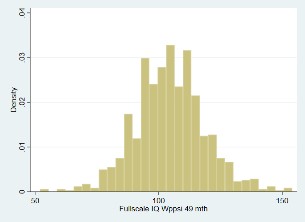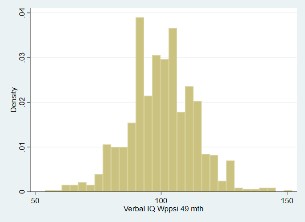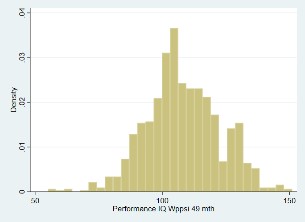The Avon Longitudinal Study of Parents and Children (ALSPAC) assessed their cohort members (CMs) at 49 months’ age (Children in Focus Clinic) using the Wechsler Preschool and Primary Scale of Intelligence Revised (WPPSI-RUK).
Details on this measure and the data collected from the CMs are outlined in the table below.
| Domain: | Verbal and non-verbal ability | ||
| Measures: | Verbal ability | ||
| Non-verbal/performance ability | |||
| CHC: | G (general ability) | ||
| Administration method: | Trained interviewer; clinical setting | ||
| Procedure: | The WPPSI-R is a measure of cognitive functioning designed for children aged 3-7 years. It is comprised of two scales, verbal and performance (non-verbal), and each of these scales contains 5 subtests. The verbal subtests are: i) vocabulary, ii) similarities, iii) arithmetic, iv) information, v) comprehension. The performance subtests are: i) object assembly, ii) geometric design, iii) block design, iv) mazes, v) picture completion. Each subtest is described individually in the sections below. The WPPSI-R provides standard scores (M = 100, SD = 15), on verbal IQ, performance IQ and fullscale IQ. Scores on the individual subtests are standardised (M = 10, SD = 3). If fewer than 3 subtests were completed by the child, verbal, performance and fullscale IQ were not computed for that child. If 4 out of 5 subscales were completed on the verbal/performance scales, the mean of the 4 scales was substituted in for the missing 5th. This prorating strategy is a standard practice when using WPPSI-R. Raw scores are converted into scale scores using tables provided in the WPPSI-R manual. | ||
| Link to questionnaire: | http://www.bristol.ac.uk/alspac/researchers/our-data/clinical-measures/ (opens in new tab) | ||
| Scoring: | Standardised score (M = 100, SD = 15) | ||
| Item-level variable(s): | Not readily available | ||
| Total score/derived variable(s): | cf801 - cf813 | ||
| Descriptives: | Fullscale IQ | Verbal IQ | Performance IQ |
| N = 1013 | N = 1,013 | N = 1,016 | |
| Range = 52 - 154 | Range = 54 - 152 | Range = 55 - 151 | |
| Mean = 104.36 | Mean = 100.13 | Mean = 107.98 | |
| SD = 14.17 | SD = 13.57 | SD = 14.56 | |
(click image to enlarge) | (click image to enlarge) | (click image to enlarge) |
|
| Age of participants: | Mean = 212.39 weeks, SD = 1.63, Range = 207 - 221 | ||
| Other sweep and/or cohort: | None | ||
| Source: | Wechsler, D. (1989). Wechsler Preschool and Primary Scale of Intelligence-Revised. WPPSI-R. Psychological Corporation. | ||
| Technical resources: | Kaufman, A. S., & Lichtenberger, E. O. (2000). Essentials of WISC-III and WPPSI-R Assessment. John Wiley & Sons Inc. | ||
| Reference examples: | Gathercole, S. E., Briscoe, J., Thorn, A., Tiffany, C., & ALSPAC Study Team. (2008). Deficits in verbal long-term memory and learning in children with poor phonological short-term memory skills. The Quarterly Journal of Experimental Psychology, 61(3), 474-490. | ||
| Taylor, C. M., Kordas, K., Golding, J., & Emond, A. M. (2017). Data relating to prenatal lead exposure and child IQ at 4 and 8 years old in the Avon Longitudinal Study of Parents and Children. Neurotoxicology, 62, 224-230. | |||
For the named items in the table above, links are provided (where applicable) to their corresponding content on CLOSER Discovery. Where a variable range is provided, full variable lists can be accessed through the ‘Variable Groups’ tab on the linked Discovery page.
Go to:
- Overview of all cognitive measures in ALSPAC
- Overview of childhood cognitive measures across all studies
This page is part of CLOSER’s ‘A guide to the cognitive measures in five British birth cohort studies’.
